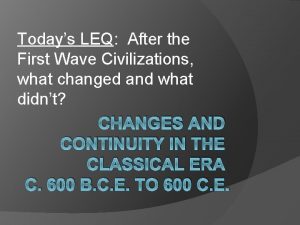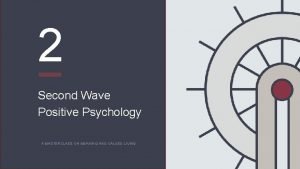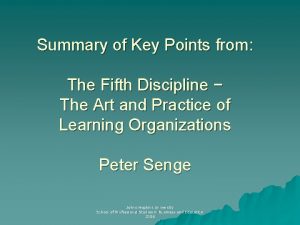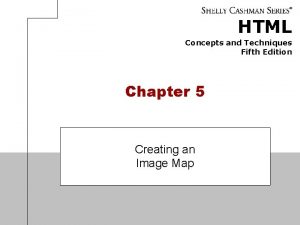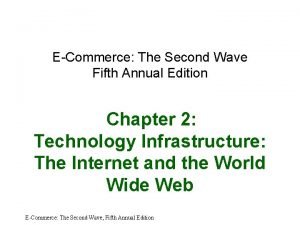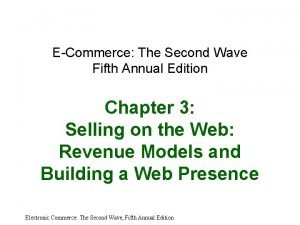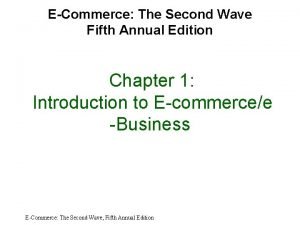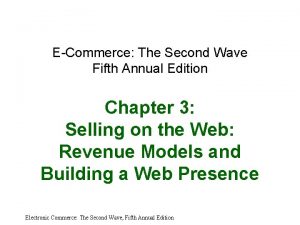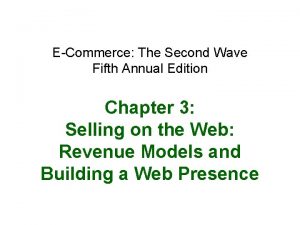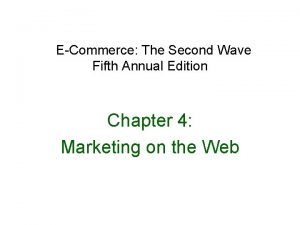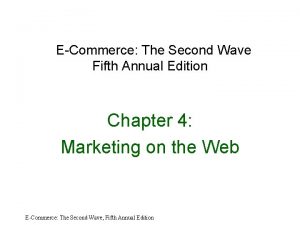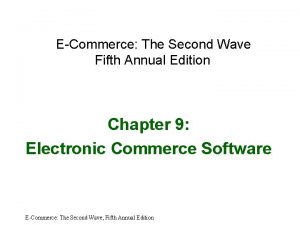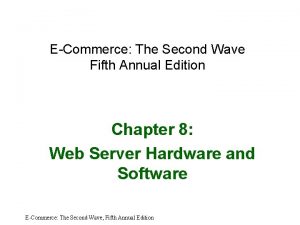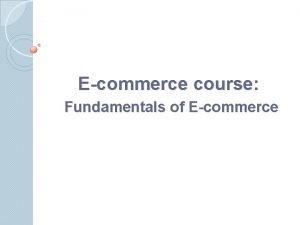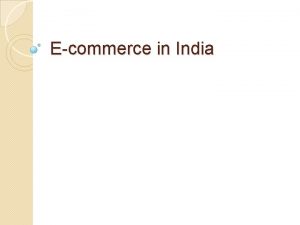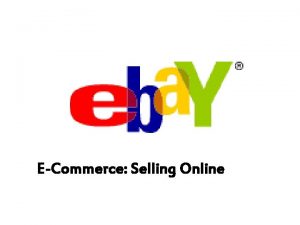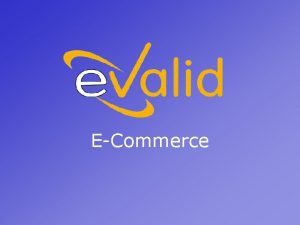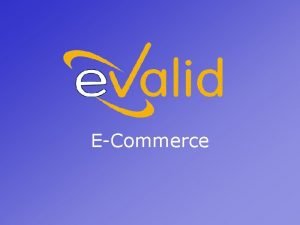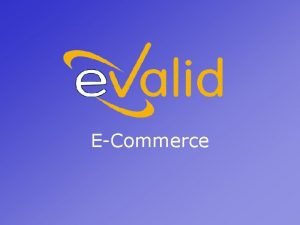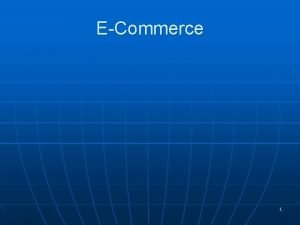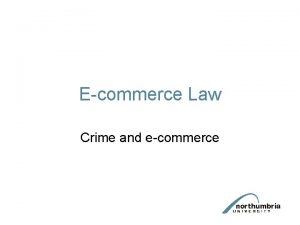ECommerce The Second Wave Fifth Annual Edition Chapter





































- Slides: 37

E-Commerce: The Second Wave Fifth Annual Edition Chapter 12: Planning for Electronic Commerce E-Commerce: The Second Wave, Fifth Annual Edition

Objectives In this chapter, you will learn about: • Planning electronic commerce initiatives • Strategies for developing electronic commerce Web sites • Managing electronic commerce implementations E-Commerce: The Second Wave, Fifth Annual Edition 2

Planning Electronic Commerce Initiatives • Objectives of electronic commerce – Increasing sales in existing markets – Opening new markets – Serving existing customers better – Identifying new vendors – Coordinating more efficiently with existing vendors – Recruiting employees more effectively E-Commerce: The Second Wave, Fifth Annual Edition 3

Linking Objectives to Business Strategies • Downstream strategies – Used to improve the value that the business provides to its customers • Upstream strategies – Focus on reducing costs or generating value • Work with suppliers or inbound shipping and freight service providers E-Commerce: The Second Wave, Fifth Annual Edition 4

Linking Objectives to Business Strategies (Continued) • Electronic commerce opportunities can inspire businesses to undertake activities such as – Building brands – Enhancing existing marketing programs – Selling products and services – Selling advertising – Developing a better understanding of customer needs E-Commerce: The Second Wave, Fifth Annual Edition 5

Measuring Benefits • Tangible benefits of electronic commerce initiatives – Increased sales – Reduced costs • Intangible benefits of electronic commerce initiatives – Increased customer satisfaction E-Commerce: The Second Wave, Fifth Annual Edition 6

Measuring the Benefits of Electronic Commerce Initiatives E-Commerce: The Second Wave, Fifth Annual Edition 7

Managing Costs • Total cost of ownership – Includes costs of hardware, software, design work outsourced, and salaries • Change management – Process of helping employees cope with changes • Opportunity costs – Lost benefits from an action not taken E-Commerce: The Second Wave, Fifth Annual Edition 8

Web Site Costs • International Data Corporation and Gartner, Inc. – Cost for large company to build and implement entry-level electronic commerce site is about $1 million • 79 percent of cost is labor related • 10 percent is the cost of software • 11 percent is the cost of hardware E-Commerce: The Second Wave, Fifth Annual Edition 9

Starting a Web Business: Three Price Tags E-Commerce: The Second Wave, Fifth Annual Edition 10

Web Site Costs (Continued) • Experts agree that annual cost to maintain and improve site will be – 50 and 200 percent of initial cost • Mc. Kinsey & Company study – Full portal site cost estimate was $2. 4 million to build and $4. 3 million per year to maintain – Companion site cost estimate was $150, 000 to build and $270, 000 per year to maintain E-Commerce: The Second Wave, Fifth Annual Edition 11

Cost Estimates for Building and Operating Magazine Publisher Web Sites E-Commerce: The Second Wave, Fifth Annual Edition 12

Cost Estimates for Building and Operating Magazine Publisher Web Sites (Continued) E-Commerce: The Second Wave, Fifth Annual Edition 13

Comparing Benefits to Costs • Capital projects (Capital investments) – Major investments in equipment, personnel, and other assets • Key part of creating business plan for electronic commerce initiatives – Identifying potential benefits – Identifying costs required to generate benefits – Evaluating whether benefits exceed costs E-Commerce: The Second Wave, Fifth Annual Edition 14

Cost/benefit Evaluation of Electronic Commerce Strategy Elements E-Commerce: The Second Wave, Fifth Annual Edition 15

Return on Investment (ROI) • Techniques provide a quantitative expression of a comfortable benefit-to-cost margin • Built-in biases that can lead managers to make poor decisions – ROI requires that all costs and benefits be stated in dollars – Focus is on benefits that can be predicted – Tends to emphasize short-run benefits over long-run benefits E-Commerce: The Second Wave, Fifth Annual Edition 16

Strategies for Developing Electronic Commerce Web Sites • Typical early Web site – Static brochure not updated frequently – Seldom had any capabilities for helping the company’s customers • Today’s Web site includes – Transaction-processing tools – Automated homes for business processes of all kinds E-Commerce: The Second Wave, Fifth Annual Edition 17

Increasing Complexity of Web Site Functions E-Commerce: The Second Wave, Fifth Annual Edition 18

Internal Development vs. Outsourcing • Outsourcing – Hiring another company to provide outside support for all or part of a project • Internal team – Should include people with enough knowledge about the Internet and its technologies – Should be creative thinkers • Measuring achievements of internal team is very important E-Commerce: The Second Wave, Fifth Annual Edition 19

Early Outsourcing • Outsource initial site design and development to launch project quickly • Outsourcing team trains company’s information systems professionals in the new technology • It is best to have – Company’s own information systems people working closely with outsourcing team E-Commerce: The Second Wave, Fifth Annual Edition 20

Late Outsourcing • Information systems professionals – Do initial design and development work – Implement system – Operate system until it becomes a stable part of business operation • Once company has gained competitive advantage • Maintenance of electronic commerce system can be outsourced E-Commerce: The Second Wave, Fifth Annual Edition 21

Partial Outsourcing • Company identifies specific portions of the project that can be completely: – Designed, developed, implemented, and operated by another firm • Many smaller Web sites – Outsource their e-mail handling and response functions E-Commerce: The Second Wave, Fifth Annual Edition 22

Selecting a Hosting Service • Factors to evaluate when selecting a hosting service – Functionality – Reliability – Bandwidth and server scalability – Security – Backup and disaster recovery – Cost E-Commerce: The Second Wave, Fifth Annual Edition 23

New Methods for Implementing Partial Outsourcing • Incubators – Company that offers start-up companies a physical location with • Offices, accounting and legal assistance • Computers, and Internet connections – Receive ownership interest in company E-Commerce: The Second Wave, Fifth Annual Edition 24

New Methods for Implementing Partial Outsourcing (Continued) • Fast venturing – Existing company that wants to launch an electronic commerce initiative joins external equity partners and operational partners • Equity partners – Banks or venture capitalists • Operational partners – Firms that have experience in moving projects along and scaling up prototypes E-Commerce: The Second Wave, Fifth Annual Edition 25

Elements of Fast Venturing E-Commerce: The Second Wave, Fifth Annual Edition 26

Managing Electronic Commerce Implementations • Project management – Formal techniques for planning and controlling activities undertaken to achieve a specific goal • Project plan – Includes criteria for cost, schedule, and performance • Project management software products – Microsoft Project – Primavera Project Planner E-Commerce: The Second Wave, Fifth Annual Edition 27

Tracking Activities in Primavera Project Planner E-Commerce: The Second Wave, Fifth Annual Edition 28

Project Portfolio Management • Each project is monitored as if it were an investment in a financial portfolio • Chief Information Officer – Records projects in a list – Updates list with current information about each project’s status – Assigns ranking for each project based on importance and level of risk E-Commerce: The Second Wave, Fifth Annual Edition 29

Staffing for Electronic Commerce • General areas of staffing – Business managers – Project managers – Account managers – Applications specialists – Web programmers – Web graphics designers – Customer service – Systems administration E-Commerce: The Second Wave, Fifth Annual Edition 30

General Areas of Staffing • Business manager – Should be member of internal team that sets objectives for project • Project manager – Person with specific training or skills in • Tracking costs and accomplishment of specific objectives • Account manager – Keeps track of multiple Web sites in use by a project E-Commerce: The Second Wave, Fifth Annual Edition 31

General Areas of Staffing (Continued) • Applications specialists – Maintain accounting, human resources, and logistics software • Web programmers – Design and write underlying code for dynamic database-driven Web pages has increased • Web graphics designer – Person trained in art, layout, and composition – Understands how Web pages are constructed E-Commerce: The Second Wave, Fifth Annual Edition 32

General Areas of Staffing (Continued) • Customer service personnel – Help design and implement customer relationship management activities • Call center – Company that handles incoming customer telephone calls and e-mails for other companies • Systems administrator – Responsible for the system’s reliable and secure operation E-Commerce: The Second Wave, Fifth Annual Edition 33

Postimplementation Audit • Formal review of a project after it is up and running • Gives managers a chance to examine – Objectives – Performance specifications – Cost estimates – Scheduled delivery dates E-Commerce: The Second Wave, Fifth Annual Edition 34

Postimplementation Audit (Continued) • Allows internal team, business manager, and project manager to – Raise questions about the project’s objectives – Provide feedback on strategies • Final report should analyze – Project’s overall performance – How well the project was administered – Specific performance of the project team(s) E-Commerce: The Second Wave, Fifth Annual Edition 35

Summary • Plans for electronic commerce implementations – Set objectives – Benefit and cost objectives should be stated in measurable terms • Project evaluation technique – Return on investment • Determining an outsourcing strategy – Form internal team that includes knowledgeable individuals from within company E-Commerce: The Second Wave, Fifth Annual Edition 36

Summary • Project management – Formal way to plan and control specific tasks and resources used in a project • Project portfolio management techniques – Used to track and make trade-offs among multiple ongoing projects • Critical staffing areas – Business management – Application specialists – Systems administration E-Commerce: The Second Wave, Fifth Annual Edition 37
 First second third fourth fifth
First second third fourth fifth Nic interventions
Nic interventions Principles of marketing fifth european edition
Principles of marketing fifth european edition Lazarus appraisal theory
Lazarus appraisal theory Fundamentals of corporate finance fifth edition
Fundamentals of corporate finance fifth edition Fifth edition chemistry a molecular approach
Fifth edition chemistry a molecular approach Molecular biology of the cell fifth edition
Molecular biology of the cell fifth edition Molecular biology
Molecular biology Human anatomy fifth edition
Human anatomy fifth edition Human anatomy fifth edition
Human anatomy fifth edition 27 miles per gallon into kilometers per liter
27 miles per gallon into kilometers per liter Advanced word power second edition answers
Advanced word power second edition answers Accounting principles second canadian edition
Accounting principles second canadian edition Accounting principles second canadian edition
Accounting principles second canadian edition Accounting principles second canadian edition
Accounting principles second canadian edition Clear thinking and writing
Clear thinking and writing Accounting principles second canadian edition
Accounting principles second canadian edition Kaufman test of educational achievement scores
Kaufman test of educational achievement scores Introduction to algorithms 2nd edition
Introduction to algorithms 2nd edition In company second edition
In company second edition Wechsler individual achievement test second edition
Wechsler individual achievement test second edition Ten steps to advanced reading 2nd edition answers
Ten steps to advanced reading 2nd edition answers Organic chemistry
Organic chemistry Using mis 10th edition
Using mis 10th edition Mis
Mis Second wave of colonialism
Second wave of colonialism Third wave civilizations
Third wave civilizations Second wave of positive psychology
Second wave of positive psychology The harder you push the harder the system pushes back
The harder you push the harder the system pushes back Fifth chapter menu
Fifth chapter menu Longitudinal wave vs transverse wave
Longitudinal wave vs transverse wave Long waves and short waves
Long waves and short waves Difference between full wave and half wave rectifier
Difference between full wave and half wave rectifier Difference between transverse wave and longitudinal wave
Difference between transverse wave and longitudinal wave Examples of half wave rectifier
Examples of half wave rectifier Center tapped full wave rectifier calculator
Center tapped full wave rectifier calculator Earthquake p wave and swave travel time
Earthquake p wave and swave travel time Rectified sine wave fourier series
Rectified sine wave fourier series


























